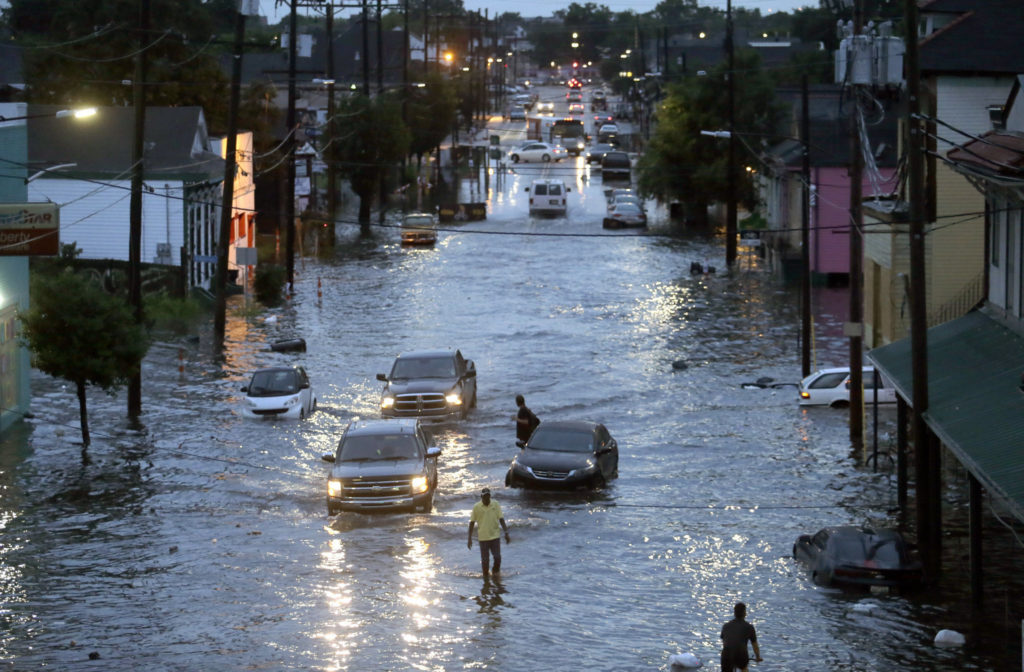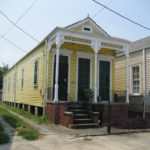Southern Louisiana, and specifically the portions of New Orleans in the lowlying, poor neighborhoods, has an undeniably apocalyptic feel. This occurs through a conspiracy of influences, which pull together to create a city which feels as though it may be the last on earth (and never without charm).
It is an old city. Its narrow, cobbled streets have caressed the levees and the river for three hundred years. Cardinal directions are useless here. No street extends in a straight line for more than a quarter of a mile before it skews again to match the oxbow of the Mississippi, and Tim explains that “no one knows where the fuck north is. You go toward the river or away from it; up or down.” It is an unsettling sensation, coming from a neatly numbered grid of streets, to get tangled in a web of crooked avenues.
The landscape is absolutely flat, and without some familiarity with where the river lies, directional advice like “uptown” or “down from there” is wholly useless. The only ubiquitously visible landmarks in the city seem to be the super dome, where the Saints play, and a handful of abandoned skyscrapers in the business district. Even so, the streets wrap around them in a way that their arrangement against each other is essential to where you are, and navigating by landmark in New Orleans feels a bit like sailing by the stars.
This feels fitting, with the rich, maritime history of the place, and there are businesses here (bars, mostly) that are older than the United States. The narrows and corners of the city feel authentically aged, a departure from the amusement park styling of the historic boroughs of New England. The honest old age is compounded by the fact that this is not a particularly clean place. Litter piles in clogged street drains and the back corners of Parasol’s do not appear to have been cleaned in decades. Walking a dog through the French Quarter reveal that everything there is coated with a thin veneer of urine.
The bars here do not close at any mandated time, and music leaks from beneath the doors until the bartender stops making money and throws everyone out. Four a.m.? Five? Daybreak? Styrofoam to-go cups and takeaway food wrappers and shopping bags and cheap rain coats and all manners of plastic detritus fill the streets each night and in the very early mornings an army of sanitation staff emerges to primp and preen the tourist haunts as best they can to prepare Bourbon Street for another day of shopping and rum.
The squalor of New Orleans cannot be unique. When four hundred thousand people live stacked on top of each other a degree of mess cannot be avoided. But here the blowing debris and the sheer age of the buildings are compounded by the moisture. This is the third wettest city in the US. 65 inches of rain fall each year. Most of it comes during the late-summer hurricane season, but all year the air approaches saturation and the marshlands and swamps seem to be forever lapping at its fringes to reclaim the Crescent City.
Fog drifts across the streets on cool nights and every surface feels damp at all times. A moss or mold so deeply green that it is black creeps across park benches and law firms, sidewalks and police cars. Roofs leak and plaster swells and cracks. Porches sag on soft foundations and as a chilling kind of true ghost story, high water marks from Katrina still scar the poorer houses a decade later.
Katrina marks, undeniably, a transformative moment for the city. Like Lexington and Concord, or Pearl Harbor, or September 11, it was an irrecoverable moment in history that fundamentally shifted what the word normal can pretend to mean. Chris Rose dedicated his collection of essays to
“Thomas Coleman, a retired longshoreman, who died in his attic at 2214 St. Roch Avenue in New Orleans’ 8th Ward on or about August 29, 2005. He had a can of juice and a bedspread at his side when the waters rose. There were more than a thousand like him.”
Unlike an act of War, Katrina left a wake of devastation without an enemy to strike back against. You cannot bomb a culture of indifference. There are no surgical strikes against a warming climate or rising tides. No clandestine commando raid can undo 300 years of hubris. We can only lament the loss and cast blame wherever it can land – on the ones who died. The poor who could not or did not leave or had nowhere to go or had no idea how bad things could really be. Or the looters, left to fend for themselves as the inadequacy of our shared disaster relief played out on the evening news and the police started shooting.
When we talk about a post apocalyptic feel in the city, it is because these people have experience an apocalypse. And as pockets of the city grow back swaths are locked in decay. Poverty is inseparable from any honest discussion of life in New Orleans in the same way that it is inseparable from any honest discussion of life in America.
Take more than a few steps from the bustling muffaleta shops and coffee joints by the World War II museum and you will find rows of buildings with rough squares of OSB screwed across the windows. Mold grows along the bottoms where floodwaters carried lives away. Many have burned and sit as charred frames aside schoolyards and basketball practice.
I ask Tim what happened with the fires, whether it’s for the copper in the walls, or what. He shrugs. Maybe it’s the pipes and the wire. Maybe it’s insurance – almost no one was covered for flooding when the storm came and so fire is, for many, the only way to rebuild. And then maybe it’s just the same scourge of poverty that drives crime in the first place: boredom and hopelessness.
The Art of the Deal
The rooster in question is four feet tall. He’s one of those rare, proud birds that struts less with hubris or panache as much as ... Read more



